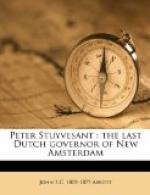And now the English made vigorous efforts to gain all the lands as far west as the Hudson river. A village of fifty log huts soon rose at Stratford, near the Housatonic. Enterprising emigrants also pushed forward as far as Norwalk, Stamford and Greenwich. The colony at Saybrook consisted in 1640, of a hundred houses, and a fine church. The Dutch now held, in the Connecticut valley, only the flat lands around fort Hope. And even these the English began to plough up. They cudgelled those of the Dutch garrison who opposed them, saying, “It would be a sin to leave uncultivated so valuable a land which can produce such excellent corn.”
The English now laid claim to the whole of Long Island, and commenced a settlement at its eastern extremity. In the meantime very bitter complaints were sent to Holland respecting the incapacity of the Director Van Twiller. It was said that he, neglecting the affairs of the colony, was directing all his energies to enriching himself. He had become, it was reported, the richest landholder in the province. Though sustained by very powerful friends, he was removed.
William Kieft was appointed in his stead, the fifth Director. He was a man of very unenviable reputation, and his administration was far from successful. Mr. Brodhead gives the following true and very interesting account of the abundant natural resources of the Dutch settlements on the Hudson at this time:
“The colonists lived amid nature’s richest profusion. In the forests, by the water side, and on the islands, grew a rank abundance of nuts and plums. The hills were covered with thickets of blackberries. On the flat lands, near the rivers, wild strawberries came up so plentifully that the people went there to lie down and eat them. Vines, covered with grapes as good and sweet as in Holland, clambered over the loftiest trees. Deer abounded in the forests, in harvest time and autumn, as fat as any Holland deer can be. Enormous wild turkeys and myriads of partridges, pheasants and pigeons roosted in the neighboring woods. Sometimes the turkeys and deer came down to the houses of the colonists to feed. A stag was frequently sold by the Indians for a loaf of bread, or a knife, or even for a tobacco pipe. The river produced the finest fish. There was a great plenty of sturgeon, which, at that time, the Christians did not make use of, but the Indians ate them greedily. Flax and hemp grew spontaneously. Peltries and hides were brought in great quantities, by the savages, and sold for trifles. The land was very well provisioned with all the necessaries of life."[6]
Thus far, as a general rule, friendly relations had existed between the Dutch and the Indians. But all sorts of characters were now emigrating from the old world. The Indians were often defrauded, or treated harshly. Individuals among the natives retaliated by stealing. When caught they were severely punished. Notwithstanding the government prohibited the sale of muskets to the Indians, so eager were the savages to gain these weapons, so invaluable to them on their hunting-fields, that they would offer almost any price for them. Thus the Mohawks ere long obtained “guns, powder and bullets for four hundred warriors.”




